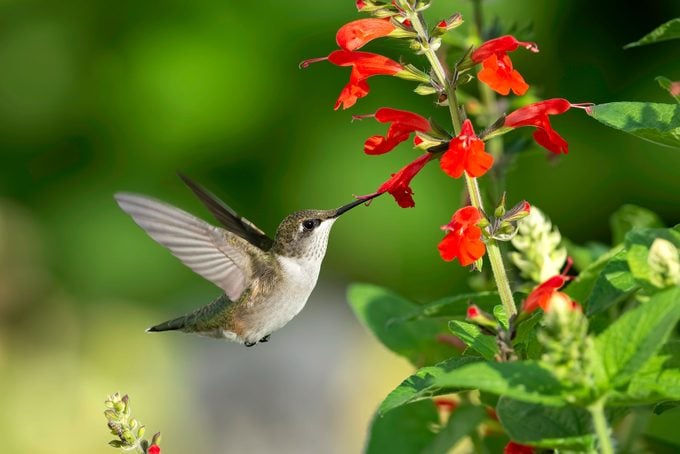What Plants Do Hummingbirds Love Most?
Updated: Apr. 16, 2024
How to attract hummingbirds from spring until autumn by planting these seven beautiful and valuable plants in your backyard and garden.

There’s nothing like being buzzed in the garden as hummingbirds dash from bloom to bloom. It’s a big deal with my gardening and birding friends when hummingbirds arrive in the area, and it feels like winning the lottery when these tiny, glittering delights choose the flowers in our own yards and gardens.
For those like me who want to attract hummingbirds, there are plenty of beautiful flower options and tips to encourage them to visit your backyard.
On This Page
Flowers That Attract Hummingbirds
I spoke with Kathi and Michael Rock in Madison, WI, who have been documenting what flowers hummingbirds utilize in their region for 25 years. For gardeners who are looking for new varieties of hummingbird-favored flowers, Kathi offers good advice: “We believe, in terms of gardening, that it’s important to have something blooming from mid-May to mid-October.”
While the time frame changes for each region, aim to include plants that bloom prior to migration.
Cardinal Flower
Hardy between Zones 3 to 9, cardinal flower (Lobelia cardinalis) grows between 3 to 6 ft. tall, making it a striking plant in the garden. It prefers full sun and is naturally found in wet areas, so ample water is a must.
Why hummingbirds are attracted to this plant: The brilliant red, nectar-rich, blossoms of cardinal flower entice hummingbirds because the plant depends upon them for pollination.
Large Firecracker Plant ‘Vermillionaire’
The large firecracker plant Vermillionaire’ (Cuphea hybrid ‘Cupver’) is the only member of the large Cuphea family (which has over 200 species) that hummingbirds love. This variety boasts orange-red tubular flowers and grows in a beautiful mounding habit, reaching 30 inches tall and up to 2 ft. across. Grown best in Zones 8 to 11, they can be kept in a large container in cooler climates. They bloom vigorously until a frost.
Why hummingbirds are attracted to this plant: Their tubular, nectar-rich flowers are perfect for hummingbirds, plus it lasts long into the season when food resources are most needed.
Salvia ‘Amistad’
“One of our favorites is Salvia ‘Amistad.’ It can easily grow 5 ft. tall, blooms continuously and doesn’t need deadheading,” says Michael. Even though this perennial is only hardy in Zones 8 to 10, it can be dug up and overwintered in a garage. Plant it in full sun and keep it well-watered for the best blooms.
Why hummingbirds are attracted to this plant: “September is for salvias,” says Kathi. This includes ‘Amistad’ because it blooms into this important season when hummingbirds are doubling their body weight before their migration, says Kathi.
Red Firecracker Penstemon
Some of my favorite hummingbird flowers, or flowers in general, are any member of the penstemon family. For hummingbirds, the red firecracker penstemon (Penstemon eatonii) is a classic choice. Hardy between Zones 4 to 9, they grow best when they receive sun in the morning, but are protected from the afternoon heat. Growing up to 2 ft. tall and a foot wide, they don’t take up a lot of space for their value as a nectar plant.
Why hummingbirds are attracted to this plant: The bright red, tubular flowers are neatly arranged along the tall stem, making them very accessible for hummingbirds. A single plant can produce up to thirty stems. Hummingbirds love it so much, they’ll even fight over the territory around the plants!
Honeysuckle Vine
“Honeysuckle vines grow just about everywhere,” says Kathi. Because Japanese honeysuckle (Lonicera Japonica) is considered invasive in many parts of the country, look for trumpet honeysuckle (Lonicera sempervirens) instead. These hardy perennial vines require a sturdy support system, and they grow well in full to partial sunshine.
Why hummingbirds are attracted to this plant: The tubular, nectar-rich flowers are seemingly built for hummingbirds, and they bloom from mid-spring to the end of summer.
Pussy Willows
One of the easiest shrubs to grow, pussy willows thrive in sunny areas and are best suited for the outskirt of your lawn or garden. Depending on the variety, they can be a wild-looking shrub or a neatly trimmed weeping variety that adds a new level of interest to the garden.
Why hummingbirds are attracted to this plant: “When selecting plants that attract hummingbirds, you want to think about not only plants that would be a good source of nectar, but also a good source of nesting materials,” says Marlene Pantin, partnerships manager for National Audubon Society’s Plants for Birds program.
Tips to Attract Hummingbirds
Get a Feeder
Because we all like to watch hummingbirds, feeders are popular for many of us. The Rocks recommend changing them every three to five days, and use a mixture of four parts water to one part granulated sugar for the nectar. Nothing more is needed, as red dye is unnecessary and potentially harmful. You also shouldn’t forget that hummingbirds need water, too. “Water features, like a dripping fountain or a water mister, are a great addition, as hummingbirds like to bathe,” Pantin.
Avoid Pesticides
Most of all, it’s critical to create a healthy habitat for the hummingbirds, regardless of what’s planted. “You should avoid pesticides since hummingbirds also eat insects,” says Pantin.
About the Experts:
Kathi and Michael Rock share their 25 years of hummingbird observations with an online community, as well as conducting speaking engagements at birding and gardening events. Their annual garden tour is a huge hit for local enthusiasts, as well.
Marlene Pantin works for the National Audubon Society as partnerships manager for their Plants for Birds program. She is also a powerhouse advocate for parks and open spaces in New York.
Sources
- Fact Sheet: “Firecracker Penstemon”
- NC State Extension: “Cuphea hybrid ‘Cupver'”
- High Country Gardens: “The Hummingbirds are Back”
- Wisconsin Horticulture Division of Extension: “Cardinal Flower, Lobelia cardinalis”
- High Country Gardens: “Friendship Sage, Salvia Amistad”
